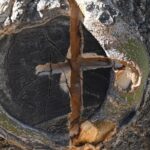Our holiday season is coming to an end. We’ve heard messages of hope, light, joy and wishes for happiness in the new year. Today’s post presents some reflections on different ways I experienced these messages this holiday and possible implications for daily life.
Geraldine and I decided a gift we would give each other this year was a Christmas “staycation”. We decided to travel the 45 minutes from Greenbelt MD to downtown Washington DC and stay in a hotel for a couple evenings and enjoy the many cultural opportunities Washington offers.
Our first experience, a play The Summer, 1976 at a community theater, showed us how creativity and the arts encourage hope and love. It’s a one-act, 90-minute play with only two actresses – dramatizing how two women became friends because their daughters played together and how their friendship grew and then ended. It is set in a time when women’s roles were changing rapidly. The storyline reminded me of the importance of making the cultivation of friendships a priority. And that intimacy with another requires risk-taking, courage and openness to letting go of preconceived ideas about someone else and the connections you might or might not make with them.
Our next stop was the National Gallery of Art. There we focused on two exhibits devoted to photography. The first was Gordon Parks: Camera Portraits. On display were 25 photos from his work as a documentary photographer from 1941 to the 1970s. As an African-American artist born in Kansas, he brought a unique humanistic style of telling through his portraits the stories of both well-known people and average citizens. The National Gallery described his work as presenting the story of “race, poverty, civil rights, and African American and American culture after World War II.”
What caught my attention was Parks’ commitment to bringing alive the strength and exuberance of African Americans and their culture. He worked as a photojournalist for Life Magazine for over twenty years. He produced photo essays on the challenging topics of the period around race and equality. Whether in his photos of Mohammed Ali and Duke Ellington or a couple on their way to church on a Sunday in Detroit or a Harlem gang leader, Parks’ photos ooze of respect for those whose stories he is capturing and of a commitment to looking for good, looking for hope. Ironically some of the photos in the exhibit were not selected for inclusion by Life Magazine, perhaps because they challenged the predominant white culture’s myths about African Americans.
Also at the National Gallery, we saw The 70’s Lens: Reimagining Documentary Photography. This exhibit of 100 photos powerfully demonstrates how documentary photography projects and the works of previously unrecognized artists offered to all a deeper appreciation for the rich diversity of America.
The National Gallery describes the significance of the period this way: “The country’s profound upheaval formed the backdrop for a revolution in documentary photography. Activism and a growing awareness and acceptance of diversity opened the field to underrepresented voices. At the same time, artistic experimentation fueled the reimagining of what documentary photographs could look like.”
I was particularly engaged with two documentary photo projects. Frank Espada visited 34 Puerto Rican communities in Puerto Rico and the US and documented through oral history and photos the Puerto Rican migration story. Like the photography of Parks, Espada brings respect and appreciation for the story of his community.
The second set of photos that I found compelling was from a series of photographs entitled The Gay Essay by Anthony Friedkin. As a 19-year-old, Friedkin successfully documented the queer communities of San Francisco and Los Angeles. And he did it years before gay marriage and advances in acceptance of LGBTQ people by the larger culture.
With both these photo essays courageous artists offered to their communities a positive, inspiring set of photos and to the larger dominant community an opportunity to move beyond stereotypes and fear in learning about people often considered “different” and therefore feared.
In experiencing these small slices of America’s rich culture and art I was reminded of the universality of hope and its presence year-round. Where might you advance hope through courageous creativity?



Thank you, Tom, for sharing these windows into America’s rich storytelling history. As a photographer, I tend to tell the stories of nature more than humans, while in my blog I do my (somewhat) more courageous storytelling. I’m grateful for this reminder of how these two formats are intimately connected. I pray I may remember to be more courageous through them in 2025…!
Peace,
Shirin
Thnaks Shirin, indeed there are many forms of art and many opportunities to combine courage, work for justice and art. Thanks for the ways you pracice that.